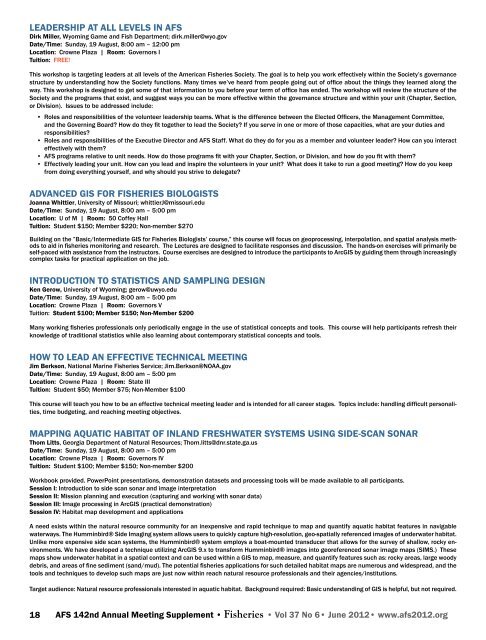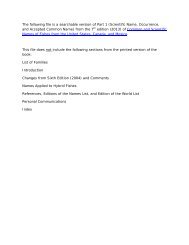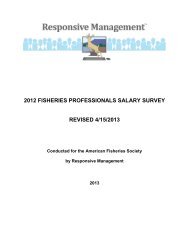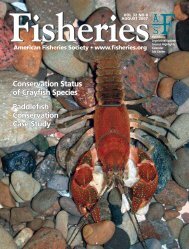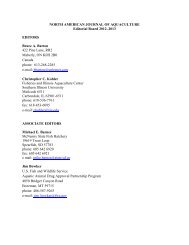AFS 142nd ANNUAL MEETING REGISTRATION - American ...
AFS 142nd ANNUAL MEETING REGISTRATION - American ...
AFS 142nd ANNUAL MEETING REGISTRATION - American ...
You also want an ePaper? Increase the reach of your titles
YUMPU automatically turns print PDFs into web optimized ePapers that Google loves.
LEADERSHIP AT ALL LEVELS IN <strong>AFS</strong><br />
Dirk Miller, Wyoming Game and Fish Department; dirk.miller@wyo.gov<br />
Date/Time: Sunday, 19 August, 8:00 am – 12:00 pm<br />
Location: Crowne Plaza | Room: Governors I<br />
Tuition: FREE!<br />
This workshop is targeting leaders at all levels of the <strong>American</strong> Fisheries Society. The goal is to help you work effectively within the Society’s governance<br />
structure by understanding how the Society functions. Many times we’ve heard from people going out of office about the things they learned along the<br />
way. This workshop is designed to get some of that information to you before your term of office has ended. The workshop will review the structure of the<br />
Society and the programs that exist, and suggest ways you can be more effective within the governance structure and within your unit (Chapter, Section,<br />
or Division). Issues to be addressed include:<br />
• Roles and responsibilities of the volunteer leadership teams. What is the difference between the Elected Officers, the Management Committee,<br />
and the Governing Board? How do they fit together to lead the Society? If you serve in one or more of those capacities, what are your duties and<br />
responsibilities?<br />
• Roles and responsibilities of the Executive Director and <strong>AFS</strong> Staff. What do they do for you as a member and volunteer leader? How can you interact<br />
effectively with them?<br />
• <strong>AFS</strong> programs relative to unit needs. How do those programs fit with your Chapter, Section, or Division, and how do you fit with them?<br />
• Effectively leading your unit. How can you lead and inspire the volunteers in your unit? What does it take to run a good meeting? How do you keep<br />
from doing everything yourself, and why should you strive to delegate?<br />
ADVANCED GIS FOR FISHERIES BIOLOGISTS<br />
Joanna Whittier, University of Missouri; whittierJ@missouri.edu<br />
Date/Time: Sunday, 19 August, 8:00 am – 5:00 pm<br />
Location: U of M | Room: 50 Coffey Hall<br />
Tuition: Student $150; Member $220; Non-member $270<br />
Building on the ”Basic/Intermediate GIS for Fisheries Biologists’ course,” this course will focus on geoprocessing, interpolation, and spatial analysis methods<br />
to aid in fisheries monitoring and research. The Lectures are designed to facilitate responses and discussion. The hands-on exercises will primarily be<br />
self-paced with assistance from the instructors. Course exercises are designed to introduce the participants to ArcGIS by guiding them through increasingly<br />
complex tasks for practical application on the job.<br />
INTRODUCTION TO STATISTICS AND SAMPLING DESIGN<br />
Ken Gerow, University of Wyoming; gerow@uwyo.edu<br />
Date/Time: Sunday, 19 August, 8:00 am – 5:00 pm<br />
Location: Crowne Plaza | Room: Governors V<br />
Tuition: Student $100; Member $150; Non-Member $200<br />
Many working fisheries professionals only periodically engage in the use of statistical concepts and tools. This course will help participants refresh their<br />
knowledge of traditional statistics while also learning about contemporary statistical concepts and tools.<br />
HOW TO LEAD AN EFFECTIVE TECHNICAL <strong>MEETING</strong><br />
Jim Berkson, National Marine Fisheries Service; Jim.Berkson@NOAA.gov<br />
Date/Time: Sunday, 19 August, 8:00 am – 5:00 pm<br />
Location: Crowne Plaza | Room: State III<br />
Tuition: Student $50; Member $75; Non-Member $100<br />
This course will teach you how to be an effective technical meeting leader and is intended for all career stages. Topics include: handling difficult personalities,<br />
time budgeting, and reaching meeting objectives.<br />
MAPPING AQUATIC HABITAT OF INLAND FRESHWATER SYSTEMS USING SIDE-SCAN SONAR<br />
Thom Litts, Georgia Department of Natural Resources; Thom.litts@dnr.state.ga.us<br />
Date/Time: Sunday, 19 August, 8:00 am – 5:00 pm<br />
Location: Crowne Plaza | Room: Governors IV<br />
Tuition: Student $100; Member $150; Non-member $200<br />
Workbook provided. PowerPoint presentations, demonstration datasets and processing tools will be made available to all participants.<br />
Session I: Introduction to side scan sonar and image interpretation<br />
Session II: Mission planning and execution (capturing and working with sonar data)<br />
Session III: Image processing in ArcGIS (practical demonstration)<br />
Session IV: Habitat map development and applications<br />
A need exists within the natural resource community for an inexpensive and rapid technique to map and quantify aquatic habitat features in navigable<br />
waterways. The Humminbird® Side Imaging system allows users to quickly capture high-resolution, geo-spatially referenced images of underwater habitat.<br />
Unlike more expensive side scan systems, the Humminbird® system employs a boat-mounted transducer that allows for the survey of shallow, rocky environments.<br />
We have developed a technique utilizing ArcGIS 9.x to transform Humminbird® images into georeferenced sonar image maps (SIMS.) These<br />
maps show underwater habitat in a spatial context and can be used within a GIS to map, measure, and quantify features such as: rocky areas, large woody<br />
debris, and areas of fine sediment (sand/mud). The potential fisheries applications for such detailed habitat maps are numerous and widespread, and the<br />
tools and techniques to develop such maps are just now within reach natural resource professionals and their agencies/institutions.<br />
Target audience: Natural resource professionals interested in aquatic habitat. Background required: Basic understanding of GIS is helpful, but not required.<br />
18<br />
<strong>AFS</strong> <strong>142nd</strong> Annual Meeting Supplement • Fisheries • Vol 37 No 6• June 2012• www.afs2012.org


